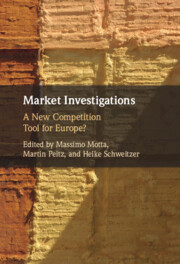Book contents
- Market Investigations
- Market Investigations
- Copyright page
- Contents
- Figures
- Tables
- Contributors
- 1 Market Investigations in the EU
- 2 Intervention Triggers and Underlying Theories of Harm
- 3 A European Market Investigation
- 4 The Integration of Wide and Narrow Market Investigations in EU Economic Law
- 5 Market Investigations in the UK and Beyond
- 6 Market Inquiries in South Africa
- 7 An Economic Evaluation of the EC’s Proposed “New Competition Tool”
- 8 Market Investigations for Digital Platforms
- Index
2 - Intervention Triggers and Underlying Theories of Harm
Published online by Cambridge University Press: 23 December 2021
- Market Investigations
- Market Investigations
- Copyright page
- Contents
- Figures
- Tables
- Contributors
- 1 Market Investigations in the EU
- 2 Intervention Triggers and Underlying Theories of Harm
- 3 A European Market Investigation
- 4 The Integration of Wide and Narrow Market Investigations in EU Economic Law
- 5 Market Investigations in the UK and Beyond
- 6 Market Inquiries in South Africa
- 7 An Economic Evaluation of the EC’s Proposed “New Competition Tool”
- 8 Market Investigations for Digital Platforms
- Index
Summary
The chapter assesses the possible role of market investigation endowed with broad remedies, when a market suffers from competition problems and infringement cases under competition law provisions are infeasible or ineffective. It lays out a number of theories of harm, i.e., reasons why certain market features or behavior by market participants may lead to consumer harm compared to a relevant counterfactual. It identifies theories of harm in markets (i) where none of the firms is dominant and (ii) with a dominant firm but article 102 TFEU is not effective or applicable or (iii) a dominant firm may arise. It also argues that the European Commission should look for simple “intervention triggers” for a market investigation. While some of the identified harms are more likely or more pronounced in digital markets, a presumption that market investigations primarily addresses competition problems in digital markets is misguided. Finally, when sector regulation is, in principle, applicable, market investigations may fill a gap between standard competition tools and sector regulation.
Keywords
- Type
- Chapter
- Information
- Market InvestigationsA New Competition Tool for Europe?, pp. 16 - 89Publisher: Cambridge University PressPrint publication year: 2022
- 1
- Cited by

